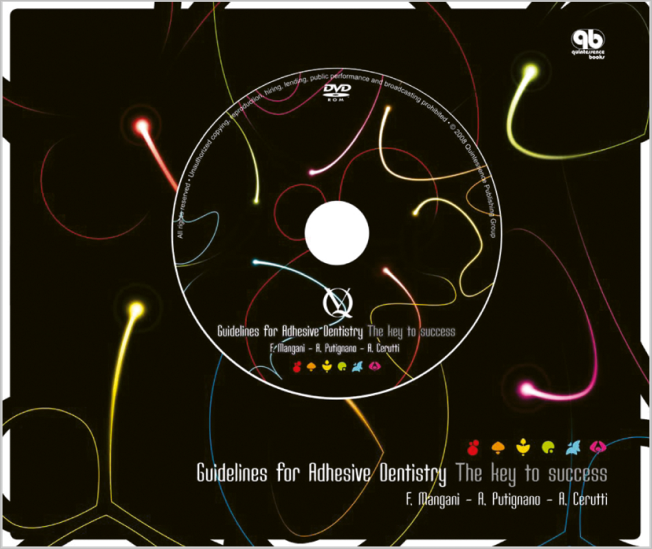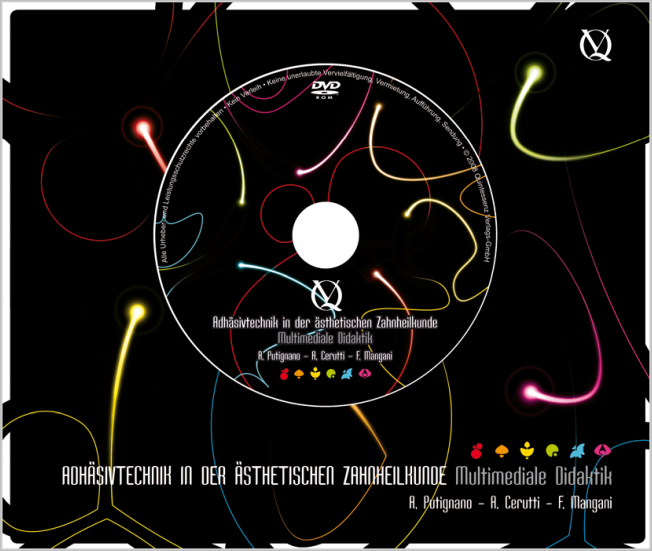The Journal of Adhesive Dentistry, 4/2020
DOI: 10.3290/j.jad.a44865, PubMed-ID: 32666060Seiten: 343-351, Sprache: EnglischCerutti, Antonio / Barabanti, Nicola / Özcan, MutluPurpose: This randomized, split-mouth clinical study evaluated the marginal quality of direct class-I and class-II restorations made of microhybrid composite that were applied using two polymerization protocols and two marginal evaluation criteria.
Materials and Methods: A total of 50 patients (mean age: 33 years) received 100 direct class-I or class-II restorations in premolars or molars. Three calibrated operators made the restorations. After conditioning the tooth with 2-step etch-and-rinse adhesive, restorations were made incrementally using microhybrid composite. Each layer was polymerized using a polymerization device operated either in regular mode (600-650 mW/cm2 for 20 s) (RM) or high-power (1200-1300 mW/cm2 for 10 s) mode (HPM). Two independent, calibrated operators evaluated the restorations 1 week (baseline) and 6 months after restoration placement, and thereafter annually up to 10 years using modified USPHS and SQUACE criteria. Data were analyzed using the Mann-Whitney U-test (α = 0.05).
Results: Alpha scores (USPHS) for marginal adaptation (76% and 74% for RM and HPM, respectively) and marginal discoloration (70% and 72%, for RM and HPM, respectively) did not show significant differences between the two polymerization protocols (p > 0.05). Alpha scores (SQUACE) for marginal adaptation (78% and 74% for RM and HPM, respectively) and marginal discoloration (70% for both RM and HPM) were also not significantly different at the 10-year year follow-up (p > 0.05).
Conclusion: Regular and high-power polymerization protocols had no influence on the stability of marginal quality of the microhybrid composite tested up to 10 years. Both modified USPHS and SQUACE criteria confirmed that regardless of the polymerization mode, marginal quality of the restorations deteriorated significantly compared to baseline (p 0.05).
Schlagwörter: photopolymerization, resin composite, USPHS, SQUACE
International Journal of Esthetic Dentistry (EN), 4/2016
PubMed-ID: 27730220Seiten: 494-504, Sprache: EnglischMensi, Magda / Scotti, Eleonora / Salgarello, Stefano / Cerutti, AntonioThe aim of this case report was to treat eight simultaneous recessions that caused an unesthetic smile in a 27-year-old orthodontically treated female patient and to restore the anterior maxillary teeth in the esthetic area. The treatment consisted of bilaminar mucogingival surgery with a palatine graft and a collagen matrix graft (Mucograft, Geistlich). At 24 months, complete root coverage was achieved in all treated sites, with an increase of keratinized tissue (KT), complete resolution of hypersensitivity, and a high level of esthetic satisfaction. This case report shows that it is possible to correct multiple unesthetic recessions in one stage thanks to the combination of a connective tissue graft (CTG), a collagen matrix graft, and a coronally advanced flap (CAF).
International Journal of Esthetic Dentistry (DE), 4/2016
Seiten: 492-502, Sprache: DeutschMensi, Magda / Scotti, Eleonora / Salgarello, Stefano / Cerutti, AntonioFür diesen Fallbericht wurden bei einer 27-jährigen kieferorthopädisch behandelten Patientin acht Rezessionen, die Lächeln und Ästhetik störten, simultan korrigiert und die Oberkieferfrontzähne ästhetisch restauriert. Zur Behandlung wurde eine bilaminäre mukogingivalchirurgische Technik mit einem Transplantat vom Gaumen und einer Kollagenmatrix (Mucograft, Geistlich) verwendet. Nach 24 Monaten war an allen behandelten Stellen eine vollständige Wurzeldeckung erreicht, das keratinisierte Gewebe verbreitert und alle Überempfindlichkeiten beseitigt. Die Patientin war mit der Ästhetik sehr zufrieden. In diesem Fallbericht wird gezeigt, dass es mit der Kombination von Bindegewebstransplantat, Kollagenmatrix und koronalem Verschiebelappen möglich ist, multiple unästhetische Rezessionen gleichzeitig in einem Eingriff zu korrigieren.
International Journal of Esthetic Dentistry (EN), 3/2016
PubMed-ID: 27433548Seiten: 314-336, Sprache: EnglischPolitano, Gianfranco / Fabianelli, Andrea / Papacchini, Federica / Cerutti, AntonioRestorative procedures are accompanied by a reduction of tooth stability, a decrease of fracture resistance, and an increase in deflection of weakened cusps. The choice between a direct or an indirect restorative technique, mainly in posterior areas, is a challenge, and involves biomechanical, anatomical, functional, esthetic, and financial considerations. In this article, the pros and cons of direct restorations are examined, as well as an analysis of indirect restorations and an overview of dental ceramics. In particular, several clinical uses of lithium disilicate overlays with a circumferential adhesive ferrule effect are proposed: heavily compromised vital teeth with thin walls, cracked teeth, and endodontically treated molars. Clinical procedures are described step by step on the basis of data from scientific literature. In conclusion, the use of lithium disilicate in combination with adhesive technologies can lead to a more conservative, economic, and esthetic approach in the restoration of heavily compromised teeth.
International Journal of Esthetic Dentistry (DE), 3/2016
Seiten: 298-321, Sprache: DeutschPolitano, Gianfranco / Fabianelli, Andrea / Papacchini, Federica / Cerutti, AntonioRestaurative Eingriffe können zur Schwächung der Zahnstabilität, Abnahme der Bruchfestigkeit und Zunahme der Verformung geschwächter Höcker führen. Die Wahl zwischen direkten und indirekten Restaurationen ist besonders im Seitenzahnbereich nicht unproblematisch und erfordert Überlegungen zur Biomechanik, Anatomie, Funktion, Ästhetik und den Kosten. In diesem Artikel werden die Argumente für und gegen direkte Restaurationen untersucht sowie eine Analyse indirekter Restaurationen und ein Überblick über Dentalkeramiken geboten. Verschiedene klinische Indikationen für Lithiumdisilikat-Overlays mit zirkumferenter adhäsiver Umfassung (Ferrule) werden genannt: stark zerstörte vitale Zähne mit dünnen Wänden, frakturierte Zähne und wurzelbehandelte Molaren. Der Behandlungsablauf wird Schritt für Schritt und auf Basis der Daten aus der Literatur beschrieben. Die Verwendung von Lithiumdisilikat in Kombination mit Adhäsivtechniken kann ein eher konservativer, ökonomischer und ästhetischer Ansatz für die Restauration stark zerstörter Zähne sein.
International Journal of Periodontics & Restorative Dentistry, 2/2015
DOI: 10.11607/prd.1802, PubMed-ID: 25738342Seiten: 220-229, Sprache: EnglischMadini, Lorenzo / Acquaviva, Pier Antonio / Krokidis, Andreas / Barabanti, Nicola / Özcan, Mutlu / Sipahi, Cumhur / Cerutti, AntonioThis study aimed to determine the effect of adhesive direct composite restorations, endodontic treatments, and fatigue treatments on the cuspal deflection of maxillary premolars subjected to different cyclic occlusal forces. Thirty intact maxillary second premolars were selected. Ten teeth were left untreated (group IN), 10 teeth were subjected to endodontic and restorative treatment (group FL), and the remaining 10 teeth were subjected to endodontic, restorative, and fatigue treatments (group FT). All teeth were subjected to 5 occlusal compressive loading forces (98, 147, 196, 245, and 294 N) with a universal testing device. A total of 15 experimental groups were obtained with 3 tooth conditions (IN, FL, FT) and 5 different occlusal loading values. Deflection amounts (μm) were measured with laser sensors and recorded, and obtained data were statistically analyzed with one-way analysis of variance at a significance level of .05. Mean cuspal deflection values (μm) and SDs of experimental groups ranged as follows: IN-98 (24.4 ± 19.8), IN-147 (34.8 ± 28.9), IN-196 (43.8 ± 34.7), IN-245 (54.5 ± 46.4), IN-294 (60.3 ± 50.6), FL-98 (56 ± 49.1), FL-147 (62.6 ± 49.6), FL-196 (72.4 ± 52.1), FL-245 (81.3 ± 56), FL-294 (92.2 ± 60.9), FT-98 (77.2 ± 80.9), FT-147 (83.4 ± 81.3), FT-196 (92.6 ± 83.7), FT-245 (102.7 ± 85.4), and FT-294 (124.2 ± 89.5). Mean values of three main experimental groups were as follows: IN (43.5 μm), FL (72.9 μm) and FT (96.0 μm). Significant differences were found between the three main groups and relevant subgroups (P .001). Highest cuspal deflection values (CDV) were obtained in FT groups. Lowest CDV were obtained in IN groups. FL groups showed higher deflection values than IN groups. CDV increased progressively as the teeth were restored and subjected to fatigue treatment.
International Journal of Esthetic Dentistry (DE), 4/2014
Seiten: 456-471, Sprache: DeutschFabbri, Giacomo / Sorrentino, Roberto / Brennan, Myra / Cerutti, AntonioFür implantatgetragene Gerüste bietet Zirkonoxid eine ästhetische Alternative zu Metall. Zirkonoxid wird vor allem aufgrund der hohen Biokompatibilität, der geringen bakteriellen Adhäsion an der Oberfläche, der hohen Biegefestigkeit und der hervorragenden mechanischen Eigenschaften zunehmend eingesetzt. Zirkonoxidgerüste für festsitzende implantatgetragene Restaurationen werden hauptsächlich manuell mit Verblendkeramik beschichtet. Dieses zahntechnische Verfahren ist hochästhetisch, kann jedoch zu einigen Komplikationen führen, wie Keramikfrakturen. In diesem Artikel wird ein innovativer Ansatz für die Erstellung einer ästhetischen, festsitzenden implantatgetragenen Keramikrestauration vorgestellt. Dabei werden mechanische Komplikationen minimiert und ihre Behebung erleichtert. Dazu werden volldeckende Lithiumdisilikat-Restaurationen auf verschraubten Implantatgerüsten aus Zirkonoxid adhäsiv befestigt.
International Journal of Esthetic Dentistry (EN), 4/2014
PubMed-ID: 25289384Seiten: 490-505, Sprache: EnglischFabbri, Giacomo / Sorrentino, Roberto / Brennan, Myra / Cerutti, AntonioThe use of zirconia is an esthetic alternative to metal for implant-supported frameworks, and it has increased primarily for its high biocompatibility, low bacterial surface adhesion, high flexural strength and high mechanical features. The zirconia frameworks in fixed prosthetic restorations that are supported by implants is commonly covered with hand-layered overlay porcelain. This technical procedure is highly esthetic but it can cause some complications, such as porcelain fractures. The purpose of this article is to introduce an innovative approach to create an esthetic fixed ceramic implant restoration to minimize and facilitate the repair of the mechanical complications, by combining the adhesive-cementation of lithium disilicate full coverage restorations on implant screw-retained zirconia frameworks.
International Journal of Esthetic Dentistry (DE), 3/2014
Seiten: 386-396, Sprache: DeutschRe, Dino / Cerutti, Francesca / Augusti, Gabriele / Cerutti, Antonio / Augusti, DavideZiel: Die Randpassung gilt als eines der wichtigsten Kriterien für Qualität und Erfolg von Vollkeramikrestaurationen. Ziel dieser In-vitro-Studie war die Untersuchung der Randpassung von Lava- Zirconia-Kronengerüsten mit einer Hohlkehl- bzw. einer Schulterpräparation.
Methoden: In zwei Kunststoff-Modellzähnen wurden unterschiedliche Präparationen vorgenommen: Ein Molar wurde mit einer Hohlkehle (C) und ein Prämolar mit einer abgerundeten Schulterpräparation (RS) versehen. Die Kunststoffmodelle wurden jeweils zehnmal mithilfe von silikonbasierten Abformmaterialien dupliziert und Arbeitsstümpfe mit Typ- IV-Dentalgips hergestellt. Insgesamt 20 Gerüste wurden in zwei Gruppen eingeteilt (n = 10 für die jeweilige Art der Präparationsgrenze). Nach dem Zufallsprinzip wurden an den Stümpfen 50 Messpunkte entlang der Präparationsgrenze ausgewählt. Die Randspaltmessung - die vertikale marginale Diskrepanz - erfolgte unter einem Lichtmikroskop mit 100-facher Vergrößerung, ohne dass die Kronen zementiert worden waren. Die durchschnittliche Breite des Randspalts und Standardabweichungen wurden berechnet und mithilfe der Einwegvarianzanalyse (ANOVA) die Unterschiede bei den verschiedenen Präparationsarten bestimmt (a = 0,05).
Ergebnisse: Der durchschnittliche Randspalt betrug 30 ± 3 μm für die C-Gruppe und 28 ± 4 μm für die RS-Gruppe. Die Einwegvarianzanalyse (ANOVA) ergab keinen statistisch signifikanten Unterschied zwischen den beiden Gruppen (P = 0,23).
Schlussfolgerungen: Innerhalb der Einschränkungen dieser Studie lagen alle Randdiskrepanzen unterhalb der festgelegten klinisch akzeptablen Grenze von 120 μm. Die Hohlkehl- und die Schulterpräparationen zeigten keine Unterschiede bezüglich der Größe des Randspalts. Klinische Signifikanz: Die Art der verwendeten Finierinstrumente ist ein leicht zu wählender Parameter vor der Präparation natürlicher Zähne. Um eine akzeptable Randpassung für die geprüften Zirkonoxidgerüste zu erreichen, erwiesen sich beide untersuchten Arten von Präparationsgrenzen als hilfreich für den Kliniker.
International Journal of Esthetic Dentistry (EN), 3/2014
PubMed-ID: 25126621Seiten: 426-435, Sprache: EnglischRe, Dino / Cerutti, Francesca / Augusti, Gabriele / Cerutti, Antonio / Augusti, DavidePurpose: Marginal fit is valued as one of the most important criteria for the clinical quality and success of all-ceramic crowns. The aim of this in vitro study was to investigate the marginal fit of Lava Zirconia crown-copings on chamfer and shoulder preparations.
Methods: Two acrylic model teeth were selected to simulate the clinical preparations: one molar was prepared with a chamfer finish line (C) and one premolar was prepared with a rounded shoulder finish line (RS). Each resin model was duplicated 10 times using silicon-based impression material and poured in type IV dental stone for the fabrication of working dies. A total of 20 copings were divided into two groups (n = 10 for each finish line). Fifty measuring locations were chosen randomly along the margin on the dies and the gap width - vertical marginal discrepancy - was measured under a light microscope with a magnification of x100. Measurements were made without cementation. The mean marginal gap widths and standard deviations were calculated and a one-way analysis of variance (ANOVA) was performed for different types of preparations in order to detect differences (α = 0.05).
Results: The mean marginal gap was 30 ± 3 μm for the C group and 28 ± 4 μm for the RS group. The one-way ANOVA showed no statistical significant difference between the two groups (P = 0.23).
Conclusions: Within the limitations of this study, the marginal discrepancies were all within the clinical acceptable standard set at 120 μm. Chamfer and shoulder preparations did not show differences regarding the gap dimension. Clinical significance: Bur design is an easily selected parameter before natural tooth preparation. Both tested finish lines are able to help clinicians in obtaining acceptable marginal fit values for the investigated zirconia copings.





